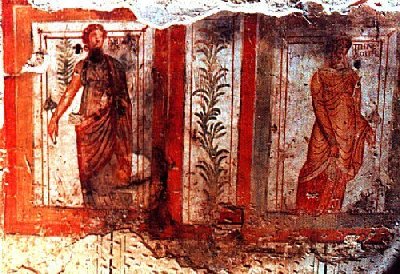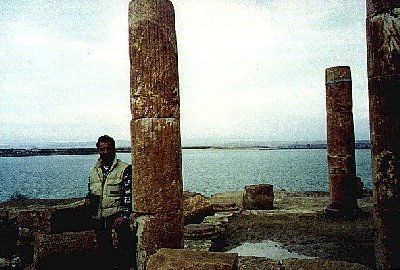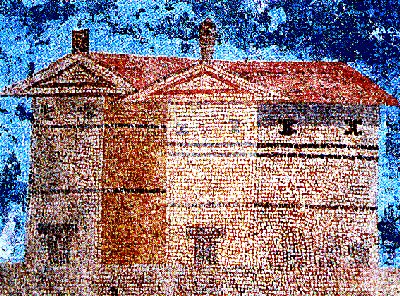

 ZEUGMA ; The city that stood here 2,000 years ago, was at the eastern edge of the Roman Empire. It had an estimated 70,000 residents and was the base for a Roman legion. ZEUGMA ; The city that stood here 2,000 years ago, was at the eastern edge of the Roman Empire. It had an estimated 70,000 residents and was the base for a Roman legion.It's position on the banks of the Euphrates River, and its role as a thriving center of Silk Road trade, made it a very wealthy city. Rich traders competed with each other to decorate the floors of their villas with the most exquisite mosaics. In the third century, Zeugma is believed to have suffered an invasion, a devastating fire and an earthquake in quick succession. It has lain undisturbed since then, covered by thick layers of dirt and rubble.  On May 2000 archaeologists have only excavated two villas, and found 12 beautiful mosaics. On May 2000 archaeologists have only excavated two villas, and found 12 beautiful mosaics.But there were hundreds of villas under the earth, so you can imagine what remains to be found. The scale of what we have here was really unbelievable (by :Stephen Kinzer /May,2000, Sunday NYTimes) Frescoes uncovered from the villas appear almost as fresh as when they were painted nearly 2,000 years ago. Beautiful mosaics depict a vanished culture's mythology. Many graceful stone columns stand in place, and around them are remains of walls and plumbing, iron window frames and lamps that illumined nights long ago. Roman legion garrisoned there. They lived in imposing houses in the hills and imported artisans, probably from Antioch, to decorate them in a style befitting their lofty station. Before the century ended, Persians sacked Zeugma, leaving the ruins to be buried by time's accumulation of dirt. Only a few lines in contemporary records bore any written trace of the city's existence. But thick layers of clay sealed off the buried site from damaging moisture, accounting for the pristine state of much of the art.(by:J.Noble Wilford June,2000,Sunday/NYTimes)  The dam that stands just half a mile from the site is part of the multibillion-dollar Southeast Anatolia Project, which is a centerpiece of Turkey's development plans. Some of the dams envisioned by the project's planners, especially one that would lead to the flooding of Hasankeyf, 200 miles east of here on the Tigris River, have become the focus of international protest. The dam that stands just half a mile from the site is part of the multibillion-dollar Southeast Anatolia Project, which is a centerpiece of Turkey's development plans. Some of the dams envisioned by the project's planners, especially one that would lead to the flooding of Hasankeyf, 200 miles east of here on the Tigris River, have become the focus of international protest.Dams in places like Hasankeyf, is not finished yet ,but the one here (Birecik Dam-at the back) is completed. Most of its gates were shut on April 29 2000 to begin the process of creating the artificial lake whose water will be used for power generation.  Beginning in 1967, archaeological work was carried out in the reservoir areas of the Keban, Karakaya and Atatürk Dams (whose construction on the Euphrates was planned within the scope of the Southeast Anatolia Project) , and discoveries important enough to change the history of civilization were made.  In the basin forming the reservoir of the Birecik Dam (under construction since 1996) , it has proved imposible to carry out essential research and salvage work. In the basin forming the reservoir of the Birecik Dam (under construction since 1996) , it has proved imposible to carry out essential research and salvage work.This area has been left to the destruction on the dams waters without fully assessing or documenting pricelees historical and archaeological remains-such as those at Belkis/Zeugma. In the same manner, the regions flora and fauna have been destroyed without being documented. Following the comletion of the Birecik and Kargamis Dams, the Euphrates-with its basin in which civilization was born- will no longer flow within Turkeys borders. We are not even in a position to fully know that we have destroyed with big investments like the Birecik Dam because no sound inventory of our countrys culturel and natural treasures has been conducted up to now (no organization has even been found to carry it out.) We are erasing from history an important segment of the cultural and natural heritage that we boast about at every opportunity. Do we really want to eliminate our cultural and natural heritage so easily? (Even the computers we use today ask us at the second or third step in our work whether or not we really want to eliminate what we are attempting to erase.) Possessing a rich cultural and natural heritage brings with its responsibility for recognizing, understanding and protecting it. The number of large infrastructure investments, and there should be a precondition for each project to document and record endangered cultural and natural heritage for future generations. This is an indisputable sign of a civilized nation.  During construction of the Birecik Dam, the most striking and painful examples of destruction included the Roman Legion camp, its bath and Early Bronze Age cemetery; the priceless mosaics and frescoes in the Roman villas at Belkis/Zeugma; and all of the cultural and natural wealth at the ancient settlement of Apameia, at the mounds of Tilbour, Tilbes, Tilmusa and Horum, at Kalemeydani and Halfeti, and in the villages of Belkis, Yesiltepe, Findikli, Asagi Çardak, Erenköy, Gümüsgün, Kalemeydani, Kasaba, Keskince, Bahceönü, Durucak, Kavaklica, Çekem, Savasan, Akçaglayan and Gözeli.(by:Nezih Basgelen/Archeology and Art Magazine/Sept-Oct.2000)  The picture of this house, is taken from the right upper corner of the "Diadolos Mosaic".The roof ,covered with red tiles, shows us the esthetique concept of 2000 years ago,which fits to the general architecture of the building. The picture of this house, is taken from the right upper corner of the "Diadolos Mosaic".The roof ,covered with red tiles, shows us the esthetique concept of 2000 years ago,which fits to the general architecture of the building.Most of the houses in Zeugma were having two or three flats according to the slope of the area that they were built and an "atrium" sorrounded by coloumned galleries.The main elements of the house were solid rocks which were put to the main corners of the basement and the wood and sun dried mud bricks to built the walls.Bricks were used to prevent the inner site from the heat of the sun,as an isolation element.The floors of the houses,including the atriums were covered with mosaics. Although the site was placed by the Euphrates,it seems that there was always a problem of water shortage in the site.Therefore ,there were atleast two water cisterns (especially located in the atriums) in every house ,in Zeugma.The pear shaped cisterns were built with a smooth inner surface to collect the rain water and the water was taken out by winding-wheels. The outlet of the waste water was planned with a waste curcuit system collected from the houses and discharged to the Euphrates. There were also store-rooms,generally carved into the rocks, used independently or connected to the main kitchen of the houses. (news translated from:Hurriyet 28 Dec.2000 / Gaziantep-A.A) |
[
Sign my Guestbook] - [Read my Guestbook
]
[Guestbook by TheGuestBook.com]



